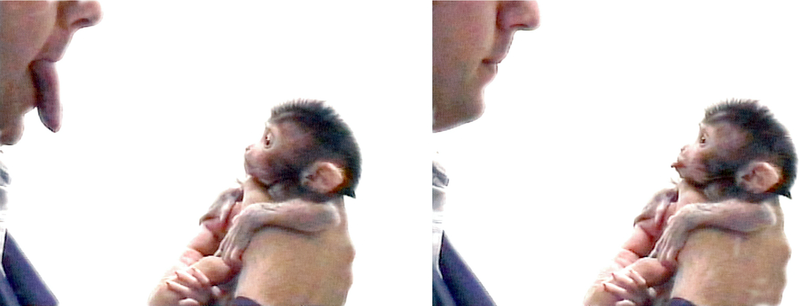At Notes from Two Scientific Psychologists, Andrew Wilson (the other is Sabrina Golonka) reflect on, “Mirror Neurons, or, What’s the Matter with Neuroscience?” (August 9, 2011), noting,
… there’s no such thing as theory-free observations – all data comes from this experiment rather than that experiment, and even simply reporting a result is laden with theoretical assumptions, even when these aren’t explicitly identified.
One thinks immediately of all the cunningly designed experiments to “demonstrate” that humans are really selfish and that chimpanzees are really altruistic. The researchers’ evidently have an emotional need to use science to demonstrate that their materialist worldview is … science, and must be accepted by all, irrespective of the usual, normal evidence.
Here the subject is “mirror neurons,” which fire whether you are doing something or watching someone else do it. As the infant macaque below is:

Great hopes abound that mirror neurons will resolve conundrums about the mind. But Wilson sees them thus:
The worst offenders, in terms of theory-laden data disguised as ‘merely the observed facts’, are mirror neurons. They are, I think, the text book example of what’s the matter with neuroscience, …
The theory around mirror neurons and the resulting studies attempt to solve a problem that doesn’t exist, he says, arguing for an ecological perspective:
perception and action are not separate domains which must somehow come into alignment. There is, instead, the single domain of ‘perception-action’; this system is how we interact functionally and successfully with the environment. The reason neuroscience looks to mirror neurons as so wonderous and amazing is that it looks to anatomy and says ‘these two things are separate, we must find out how they talk to each other’.
… anatomy is not the final arbiter here, function is. Perception-action is the function of a broad, integrated system, not the labels of distinct entities. So ‘motor’ cortex responding to ‘perceptual’ input is only astonishing if you believe these are two separate functions of the system.
There is a large range of questions that mechanism and reductionism not only don’t answer but where they actually create just these sorts of meaningless problems. In this case, the resolution is quite simple: Perception is a form of action – it is a mental action – the act of perceiving.
Hat tip: Stephanie West Allen at Brains on Purpose